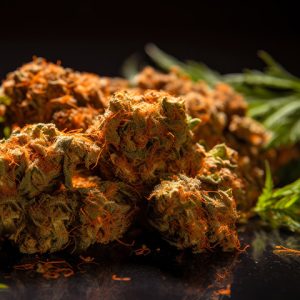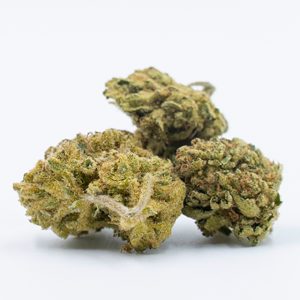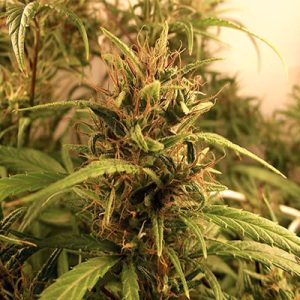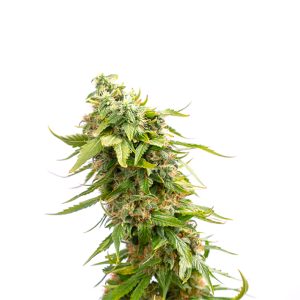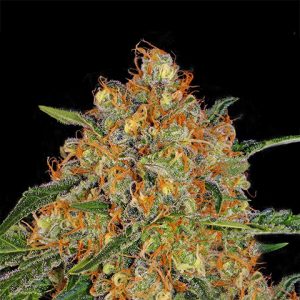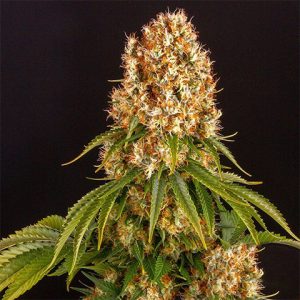Orange Strains: Cannabis with Orange Lineage
What Are Orange Seeds?
Orange strains are fruity and hardy sativa dominant plants that grow large amounts of cannabis in relatively short periods of time. These strains like to get bushy or tall quickly, depending on their specific crosses and the way they are being treated. They will grow buds from multiple sites, sometimes as small little nuggets and other times as large fluffy colas. These plants suit their family name, with notes of sweet orange and other citrus scents coming out early on in flowering. With flowering periods under three months and harvests averaging around a pound per meter squared, these are reliable crops for growers, popular with professionals and amateurs alike. Their melange of citrus flavors and friendly, activating effects make them a favorite of daytime recreational smokers, who use these strains to heighten the experience of activities with friends. Medicinally, Orange family strains have a wide array of applications. The most common use is for low mood and mental health concerns including depression, ADHD, and PTSD. However, there are strains that are also used for inflammation-based issues including arthritis and migraines, chronic pain, and muscle spasms. Some of the most popular and influential strains in the world of sativas come from the Orange family. These include California Orange, not to be confused with its child Cali Orange, Orange Bud, Tangie, Orange Velvet, Orange Cookies, and Agent Orange. KSCO loves to help people new to the wide world of cannabis genetics figure out how to grow what they need. When you buy with us, you’re part of our mission!
Where Do Orange Cannabis Seeds Come From?
The Orange family is related to the Skunk family, which is where they get their strong orange scents. It began when California Orange, Orange Velvet, and Orange Bud, most of them related to Skunk 1 in various ways, were recrossed with Skunk, but also with or with other genes to create a line of citrus wonders. Agent Orange comes from Orange Velvet and Jack the Ripper, with Orange Velvet from unspecified Skunk lines. Orange Kush seeds come from a cross of Orange Bud and OG Kush, giving it a more indica vibe. Its kid is Orange Romulan, which is popular among Pacific Northwest growers. Orange Bud is from original Skunk genetics as well. It’s possibly a sister strain to Skunk 1 that was first bred in Holland after moving there from America in the nineteen eighties. Cali Orange Seeds are related to the original California Orange, who is the mother of Tangie and Orange Crush and a mysterious balanced hybrid from the eighties. California Orange seems to originate with the Crockett family of California, a group of growers who have been in the game since the mid twentieth century. There’s also another Cali Orange Bud that was brought to the Netherlands at the same time. It’s likely related to the Crockett family genes. This Cali Orange is another Skunk cross. Orange Skunk is a hybrid between California Orange and Skunk as well albeit with a different phenotype. Orange Cookies seeds are made from crossing Orange Juice with Girl Scout Cookies. Explore WS’ vast website to find out more and order your favorites.
Why Buy Orange Seeds?
Orange family strains are the ideal group of genetics for sativa fans who enjoy uplifting citrus smokes. They have a reputation for being tall, bushy, and tough plants that do well both indoors and outdoors. Some of these strains can produce a significant amount of cannabis in a short period of time, with up to two pounds per plant possible in just three months! KSCO swears by our extensive catalog of over five hundred different seed styles, including four dozen different strains that are either direct members of the Orange Family or are related to them through crossings. All of them are delicious in their own way. And we pride ourselves on helping our customers access these next level genetics from anywhere in the country at any time of day or night. Simply browse our catalog and find the strains that are right for you. Once you’ve found your seeds, follow our simple checkout system and pick from our wide variety of payment options. We take credit cards, Venmo, Waave, and an ever-expanding variety of cryptocurrencies including Litecoin, Dogecoin, Bitcoin, Bitcoin cash, and Ethereum. If you’re having trouble for whatever reason, or if you’d like to talk about larger orders for filling warehouses and acreages, you can call our customer service line or send us an email and we’ll be happy to walk you through the process. Once you’ve placed your order, you’re only waiting between five and fourteen business days for your seeds to arrive in discrete packages. Buying from Weed Seeds is a premium experience, from browsing to harvesting!
Seed Storage Of Orange Cannabis Seeds
Orange seeds are worth taking proper care of, and there are a few simple and easy ways to make sure your seeds stay viable even during long periods of storage. The trick to keeping most pot seeds healthy and in good working condition is to keep them in cool, dry, and relatively dark places. Seeds are incredible little marvels of nature that hold living tissue under a hard shell, and that tissue can stay dormant for upwards of six months if it’s kept in the right conditions. Seeds reactivate when they sense the conditions are suitable for them to germinate, but they can be dead wrong sometimes. If seeds are in bright light, especially in small containers, the heat will build up enough that the seed might wake up. But without water, the seed will die before it even sprouts. Your premium quality Weed Seeds can be stored in the packaging we send them to you in, in a drawer or cupboard in a cool place in your home for up to two months provided the space is dry and dark. The warmth won’t hurt them too much in that time. However, if you want to store your seeds for longer it’s advised you keep them, for optimal results, in a root cellar-like storage space with a relative humidity between eight and ten percent, well below sixty-eight degrees, with little to no direct sunlight. Make sure they don’t freeze, and they’ll stay viable for a long time. Weed Seeds wants to make sure you can use our top-notch genetics for months to come.
Germinating Orange Seeds
Orange seeds need moisture and warmth to sprout, and do well with a relative humidity over sixty-five percent when they’re first growing up as seedlings. They thrive when germinated using a few household supplies. To begin, place your seeds in a cup of water overnight. Pour much of the water out and then dump the rest onto a plate lined with some paper towel. There should be enough water to get the towels wet, but not so much that there are pools left on the plate when you pick up the paper towels. Make sure each seed has around an inch of space in a radius around it. Put another piece of paper towel over top, possibly using it to soak up the excess water left over from pouring the glass out. Cover this seed sandwich with another upside-down plate. You’re creating a warm, dark, moist microclimate for your seeds to sprout in. If you live somewhere where the temperature dips below seventy degrees on a regular basis, it may be wise to use a seedling heating pad to keep the seeds at a steady temperature. Watch the seeds carefully, looking at least once a day. Keep the paper towels wet. The seeds should sprout in one to three days, and the sprouts will be ready for your seedling set up in about a week. KSCO has a high germination rate when our seeds are treated properly. So, treat them well and get ready to experience a bountiful harvest!
Growing Orange Cannabis Plants
Orange family genes grow fabulously energetic and bushy plants, with wide set leaves and plentiful bud sites. Of course, the specific style of each strain will depend on their genetics and phenotypes. How they finally turn out is a matter of environment. Orange family strains like temperatures between seventy-five and eighty degrees Fahrenheit with a relative humidity of around fifty-five percent going into the vegetative phase. They also enjoy a slightly alkaline soil compared to other cannabis families, with pH somewhere around six or six point five. Going anywhere over six point five is not advised, since it’s likely to affect the way your plants uptake nutrients. While it’s wise not to exceed a ten degree gap in temperatures between day and night, some of these plants can handle a little bit of a wider spread. Keeping nighttime temperatures above fifty-five degrees is always recommended. Lowering temperatures at night below sixty-five degrees is recommended only for the flushing period near the end of flowering, when it can help weed varieties high in anthocyanins express purple and blue hues. While this isn’t something Orange plants are famous for, certain crosses and members of this family will be able to get some impressive color. As always, it’s wise to read all about the specific strain you’re growing to find its individual preferences. That’s why KSCO provides detailed information on all our over five hundred styles of seeds, including around more than a dozen kinds of Orange buds. Peruse them today and find the ones that are ideal for your growing situation.
Growing Flowers From Orange Seeds Indoors
Plants of the Orange family do best when grown in organic living soil. It’s not that other ways aren’t possible, it’s just that the kind of terpene profiles that these strains really excel at providing will be at their most robust with the support of soil. When growing indoors, most Orange plants like a temperature between seventy-two and eighty-two degrees Fahrenheit during their vegetative phase, with average temperatures in the high seventies from vegetating through to flowering and harvesting. Many of these plants aren’t big fans of humidity, with fifty-five percent being normal for most vegetative stage environments and between forty and fifty percent being ideal for flowering phases. Many of these plants do well with low stress training techniques done early in their vegetative phase. It’s possible to use a Screen of Green on your plants to get excellent results. The Screen of Green technique uses plastic mesh screens put over the plant in a flat array to suppress the growth of canopy. Growing bud sites are woven through the mesh in order to give them access to more direct light. This can be combined with defoliation of lower leaves to keep air flow up, though it’s important to select leaves to cut off strategically. Orange plants can have fabulously strong smells of orange early on in their growing period, often starting right after they begin to flower. Whether you’re growing indoors or outdoors, greenhouse or closet, when you buy seeds from WS you know you’ll be working with the best genetics money can buy!
Growing Cannabis Flower Outdoors From Orange Seed
Plants of this family have a tendency to shoot up quite dramatically during their flowering period. They like it hot during their vegetative stage, sometimes up into the low eighties Fahrenheit. Orange strains like spaces where they can take advantage of full sunlight while still being protected from rainfall. If you have the ability to grow in a greenhouse, you can take advantage of the perks of growing indoors, like protecting your plants from rain and being able to control light and humidity a little more easily, while still using the time and money saving energy of the sun to help your plants grow. It might be less important to keep your plants small outdoors, but Orange family strains still benefit from a little bit of topping or FIMming early on in their growth to help them get bushy. Topping involves chopping the apical meristem of your plants, that is the topmost and newest portion of growth, up to and including the first node. Done once or even a few times, this tells the plant to not put all its efforts into getting tall, causing it to get bushy instead. FIMming is a very similar technique with the exact same intention, but only cuts off the leaf parts of the topmost growth rather than the whole node. It’s less stressful to the plant, and can be more easily done by novice growers without the risk of stunting your plant’s growth. For more helpful tips, and a whole lot of detailed blog posts all about specific techniques, check out Weed Seeds’ fount of growing information.
Typical Aroma Of Orange Cannabis Buds
Many Orange strains have a profound sweet orange smell from around the second week of flowering onwards. These scents only become more complex as the flowers mature, get flushed, are harvested, and go through drying and curing. Orange Kush has a floral citrus and sweet skunk aroma with notes of hashish and oil, while Orange Skunk buds have an intensely berry and earthy bouquet. The strain Orange Cookies is high in the terpenes caryophyllene, myrcene, and terpinolene which give it a sweet and spicy smell that matures into something danker. Tangie has a familiar synthetic tangerine scent that becomes spicier and more complex in a grinder. Agent Orange is sweet and tropical, almost like a creamsicle or a glass of tropical fruit blend juice. The most common terpenes in Orange family strains are the orange terpenes, limonene, and myrcene followed closely by caryophyllene. Different strains will have different amounts of each, but in general this gives orange buds a robust and complex scent mix of citrus fruit, flowers, and wood. Some strains will have notes of black pepper and lemon grass as they are ground up, while others will have hints of diesel and soil. The robust mix of astringent citrus and dankness makes these strains some of the most interesting and crowd pleasing to smoke. Thanks to KSCO’s extensive research and painstaking collection of high-quality genetics, you can try them all out! If you’re hoping to sample all four dozen of our extended Orange family, you can always buy one of our one hundred seeds customizable variety packs.
Harvesting Time When Growing Orange Strains
The average flowering time of most Orange strains is between eight and eleven weeks. Agent Orange and Orange Kush take eight to ten weeks to flower. Cali Orange Skunk has a shorter flowering time of eight to nine weeks. Orange Skunk has a slightly longer flowering time, between nine and eleven weeks. Many Orange strains can be flipped into flowering after just a few weeks of vegetation so long as they’re well fed and have recovered from any stress beforehand. While flowering week statistics are helpful in giving growers a sense of what to expect, they don’t always translate in the real world due to differences in environments and growing conditions. The most consistent and reliable way to tell when your crop is ready to harvest is to wait until the trichomes on your flowers have mostly turned white. Trichomes start out their lives clear, and need to be seen with a magnifying glass. As the THC in them collects, they turn white. As the THC degrades into CBN, another cannabinoid that is less psychoactive but better at soothing nerves and pain, the trichomes will become more golden in color, becoming deep amber and clear again as the THC wanes. To get your plant at its most potent, harvest as trichomes become roughly three-quarters white. Remember to flush your plants for a week or two before harvesting in order to bring out their most delicious flavors and flush out excess fertilizers. You can count on Kind Seed Co to always deliver the most up to date and cutting-edge growing information.
What Yield Can You Get From Orange Plants
While there are certain genetic predispositions that come into play when estimating what a yield will be, the things that really matter to a good yield are the same that help to grow a healthy plant overall. That is, the air is warm enough and circulates well and it’s also high in carbon dioxide which the plant uses to build its tissues including its flowers. The air should also be sufficiently moist without being saturated in order to support the respiration of the plant. A steady supply of appropriate nutrients throughout its life are vital to the production of plant tissues as well. Finally, your plants will need ample and intense light in order to power their photosynthetic processes. In general, Orange plants can grow roughly a pound per square meter or per plant, with variation between the specific strains. Agent Orange can grow between three hundred and fifty and four hundred and fifty grams of cannabis flowers per square meter of indoor growing table, or up to five hundred grams per plant outdoors. Orange Kush can grow around four hundred grams either per plant or per meter squared of lush indica inspired marijuana. Cali Orange Skunk can make between four hundred and six hundred grams per meter squared or per plant during its flowering period. Orange Skunk proper can make between five hundred and six hundred and fifty grams of weed per meter squared in a growing room, or up to a truly impressive eleven hundred grams per plant. Trust Weed Seeds to bring you nothing but the best!
Are Orange Buds High in THC?
Orange strains are quite popular with people who like concentrates, since their highly resinous buds always produce a reliably delicious terpene profile. Due to this high resin content, Orange buds are considered among some of the most delicious chronic strains for users who love sativas. Resin production is closely linked to THC production, because THC is produced almost entirely within the resin of the buds. Resin is produced to help increase the chances of cannabis pollen sticking to a flower as it passes by on the wind. This resin is attractive to pests like aphids, and it’s believed that THC was first produced by cannabis flowers as a kind of deterrent against herbivory. This is why a crop of sinsemilla, a crop without seeds, will have much more resin and therefore THC than other plants, as the flowers produce it in order to increase chances of conception. From there, resin production is a matter of epigenetics, phenotypes, and nutritional encouragement. To ensure your crop’s resin stays healthy, make sure to keep humidity low and air flow high during flowering. Agent Orange can have between nineteen and twenty-four percent THC packed into its creamy buds. Orange Kush can produce up to twenty-three percent. Cali Orange Skunk is one of the more moderate strains, with up to eighteen percent THC, while Orange Skunk has up to twenty-two percent. There’s up to twenty-one percent THC in the buds of Orange Cookies. For more information on the Orange strain of your choice, consult our extensive strain reviews and growing information right here at KSCO!
Typical Effects of Smoking Orange
Orange strains are known for their uplifting and energizing highs. They’re popular with daytime sativa users who are looking to focus their minds and elevate their moods without too much of the heavy and disorienting effects of other, more indica dominant strains. Agent Orange is an incredibly calming, uplifting, and energizing strain that relieves stress, anxiety, depression, and pain. The effects of Cali Orange Skunk are creative, sedative, and euphoric. It’s used for stress, anxiety, depression, migraines, inflammation, and arthritis. Orange Skunk delivers an uplifting, energetic, and euphoric high as well, much less of a sedative than Cali Orange Skunk and other more indica-influenced varieties. Orange Cookies is used for a huge variety of things, from pain and muscle spasms to stress, anxiety, depression, nausea and lack of appetite, and mood stabilization. Orange Cookies has an extensive, very relaxing and serene high with a lovely brain buzz that inspires creative thought. While body highs are not completely off the table when smoking Orange family strains, they’re typically more common with varieties like Orange Kush that have an inclusion of indica dominant genes. Orange family strains are more likely to increase appetite, reduce nausea, and help people with poor attention spans focus on tasks for long periods of time. Tangie and its relatives are favorites of students with ADHD who like to use sativa dominant cannabis flowers to help them concentrate on studying or writing long research papers. Whether you’re looking for something to take the edge off a long day or something to help you survive one, Kind Seed Co surely stocks it!
Typical Flavors of Orange Family Strains
Like their relatives in the Lemon family, Orange family strains tend to have the kind of flavors you might expect based on their name. However, the range of what orange can be is quite vast if you think about the difference between say a bitter orange rind and the juice of a clementine. Agent Orange’s flavor is all citruses, especially tangerines, lemons, and sweet oranges. It can be pretty sour and is high in caryophyllene and pinene. These give its aftertaste spicy and astringent notes. Orange Kush is high in limonene and myrcene, making it sweet but also sour and skunky. It can also have quite a complex dankness reminiscent of hash oil thanks to its OG Kush genes. Cali Orange Skunk is high in humulene, caryophyllene, myrcene, and linalool. It has an orange, sour and sweet yet woody funk reminiscent of orange wine. The strain Orange Skunk is high in caryophyllene and myrcene, bringing out its earthen funkiness. Orange Cookies is full of tropical and fruity flavors like lemon, orange, and pineapple thanks to its abundance of sweet and fermented-tasting Cookie Fam genetics. It can taste a little bit like a creamsicle. As you can see, while orange is the most dominant flavor of these strains, that can mean all kinds of different things depending on the rest of the bouquet. Some, like Orange Bud, taste more like Florida water, while others like Tangie taste more like a spoonful of Tang powder. KSCO loves thoroughly researching our products so we’re better able to help our customers get the flavors they’re after!
Baking and Making Edibles With Orange Buds
Due to their abundant sweet and citrus flavors, Orange family ganja makes fabulous edibles, especially sweeter confectionaries like gummies, chocolate, and baked goods. While more savory recipes might be a little strange depending on the specific strain used in the infusion, it could still work so long as the vaguely orange and dank flavors could mix well with whatever you’re cooking. Orange chocolate infusions have the added benefit of being slightly more psychoactive due to the interactions between cocoa and cannabis. Recipes that involve liquifying all ingredients for a period of time will help to keep the infusion even in the results. There’s nothing worse than a batch of edibles where all the THC is stuck in just a few pieces. Depending on which cannabinoids you’re interested in highlighting in your baking, it’s possible to decarboxylate your plants at different temperatures for different periods of time to bring out the THC, CBD, CBG, or CBN in them. For a traditional THC infusion, it’s smart to decarboxylate your cannabis at between one hundred and eighty and one hundred and twenty degrees Fahrenheit for around thirty minutes first. This makes creating potent butter much easier and also makes your product less bitter. Simply add your decarbed weed flowers to a saucepot with some water and butter in it and keep it below one hundred and eighty degrees Fahrenheit but at a steady simmer for sixty to ninety minutes, cool down the whole works, skim the butter off the top and you’re done! When you’re using Weed Seeds top of the line genetics, you’ll get a great batch every time!
Is It Worth It To Make Orange Cannabis Oil?
Weed Seeds believes in helping our customers make the most of their seeds. It’s highly recommended you take the time to create your own edible Orange family oil if you have the ability. Use roughly a half cup of oil to a gram of decarboxylated cannabis for a decent potency, though the final say on just how much you use is up to you. It’s suggested the oil be heated on a stove with the cannabis in it for around half an hour. It’s vitally important the oil not go over two hundred degrees if you’re using coconut oil, or lower if using olive oil. Keep the oil between one hundred and twenty and one hundred and eighty degrees for potent results. Strain out the bits of cannabis for a significantly better, less bitter and gritty product. It might even be wise to keep the cannabis in large chunks whenever possible to make this part easier. This oil can be stored in the fridge for quick use, though it’s advised that you use it within about a month maximum, as oil that’s previously been heated will go bad faster. You can make edible oil infusions without heating the oil by infusing it for a few weeks at room temperature, but this is much less hygienic than simply heating the oil for an hour. WS doesn’t recommend making RSO, or Rick Simpson oil, at home. Yes, it’s handy to have oil you can both eat and smoke, but the risk of fire is severe unless you really know what you’re doing and are prepared for an accident.
What To Expect When Smoking And Vaping Orange Concentrates
The first thing you notice when using Orange family concentrates is their taste and smell. If you’re vaping with a device that allows you to adjust the temperature, Orange strains can be explored at all levels of their terpene profiles. Starting low and working up past the combustion point can lead to a journey that begins with pine and ends with spices. Major terpenes in Orange family buds include limonene, the elusive Orange terpenes, caryophyllene, myrcene, and pinene, with some strains also including linalool, terpinolene, or humulene. If you are more interested in inhaling concentrates for their potent highs, buckle up! Orange strains typically start with a blast of facial numbness or tingling, leaving users feeling giddy and euphoric with a lightheaded afterglow. The can’t-stop-smiling effects of the first moment will then typically melt down the body to produce a satisfying and happy energy that relaxes the body. This can be a chatty high, or one very conducive to writing or other creative expression. Using Orange concentrates is quite fun with friends, as this strain supports a lot of sociability. Strong hits of Orange family concentrates may help to cure nausea quite quickly due to the large amounts of limonene in this family. It’s also possible that those using Orange concentrates will want to go on a hike, go dancing, or play low contact sports. The comedown of most Orange strain highs is deeply relaxing. While Kind Seed Co doesn’t sell any kind of concentrates, we’re always eager to help growers make the kind of crops that produce exciting 710s.
Kind Seed Co Orange Suggestions
The orange family has a wild mix of exciting genes. Here’s a list of some of the heavy-hitters. Agent Orange regular seeds have between nineteen and twenty-four percent THC. They make weed with an energetic high and a sour orange toke with strong anti-anxiety effects. These sativa dominant seeds come with males attached, so buy these for breeding pairs! Also known as Orange OG, Orange Kush seeds can grow buds with up to twenty-three percent THC. They can grow just under a pound per square meter or per plant. Orange Kush does wonders for depression and stress. It's full of laughs and provides a general sense of wellbeing. Cali Orange seeds have up to eighteen percent THC. These plants can make between four hundred and six hundred grams of cannabis per meter or plant in just over two months of flowering time. This one is a little woodier and spicier than the others, with plenty of caryophyllene in its sedative and inflammation busting nuggets. The spunky plants made by Orange Skunk strain seeds can produce up to eleven hundred grams per plant in only nine to eleven weeks of flowering time. Their high has very little haze, and the taste is both sweet and sour. Orange Skunk has up to twenty-two percent THC. Orange Cookies seeds create balanced hybrid plants with up to twenty-one percent THC. They can create around three hundred and fifty grams per meter squared or four hundred grams per plant in just eight to ten weeks of flowering time. Order them all today from Kind Seed Co!

